10 incredible winter wildlife adventures
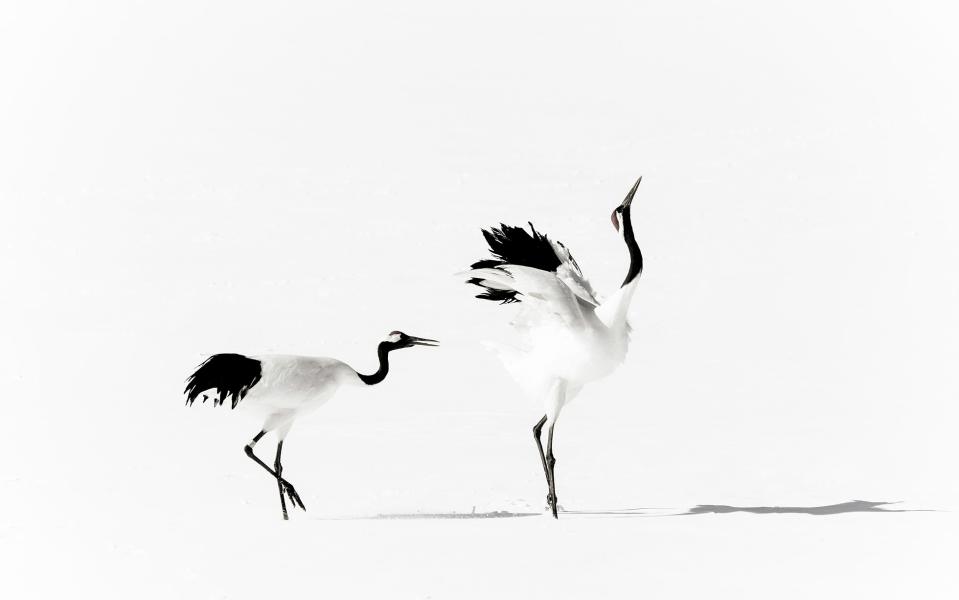
Winter exerts a special magic for anyone who puts wildlife and wild places at the top of their holiday wish list – and many of the most exciting trips coincide with the next three months.
In Antarctica it is currently the austral summer, when the sun rises above the horizon again, giving 20 hours of daylight in January and pushing the temperature to a balmy degree or two above freezing. This is also the best time of year to see snow leopards in Ladakh, northern India, or follow wolf tracks in the backwoods of Yellowstone National Park.
Closer to home, the song of the wolf echoes in the boreal forests of central Sweden, and in Poland, too, where herds of bison plod through the snowy aisles of Europe’s wild woods.
As for Britain, now is the season that birders relish, the months when our skies are filled with mass migrations of Arctic wildfowl. Even now, as you read this, the geese will be gabbling in the fields of Islay, feeding and fattening until it is time to make the return journey north.
Only in the Arctic do the inclement temperatures and absence of light conspire against the winter wildlife watcher, meaning our summer is the best time to see one of the world’s great animal A-listers, the polar bear. That iconic species appears at the end of our selection of the top 10 wildlife experiences that are enhanced by snow and the grandeur of a wintry landscape. For the rest, book now.
1. Penguins at the end of the world, Antarctica
Our northern hemisphere winter is the best time to go cruising in Antarctic waters. On and around the shores of South Georgia, the Falklands and the Antarctic Peninsula, an entire lexicon of wildlife species fills your days: whales, elephant seals, three million fur seals, nesting colonies of black-browed albatrosses and countless penguins.
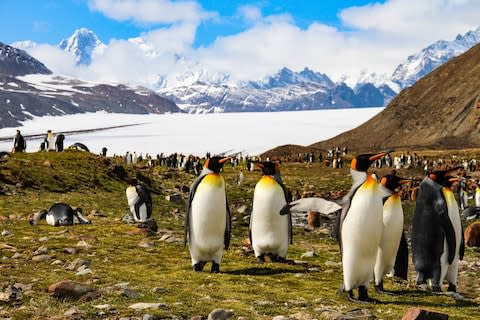
With Audley Travel, you can follow in the footsteps of the old-time explorers, but enjoy a life they never dreamed of as you cruise on board the Silver Explorer, one of the most luxurious expedition vessels in Polar waters. With almost as many staff as guests, you can enjoy such perks as a hot bath ready for you on your return from every excursion into the icy wilderness.
Audley Travel (01993 838615; audleytravel.com) is offering a 19-day cruise departing Jan 31 and returning Feb 3. Prices start at £17,750 per person including economy flights from the UK, one night in Buenos Aires and one in Ushuaia before the cruise and one in Buenos Aires on the way home.
2. Yellowstone in focus, US
Winter in Yellowstone is a magical time. The crowds have gone and the world’s oldest national park is buried in snow; but being America you can still get around, driving, walking, even putting on snowshoes in order to capture unforgettable images of steaming hot springs, deep-frozen waterfalls and frost-covered bison.
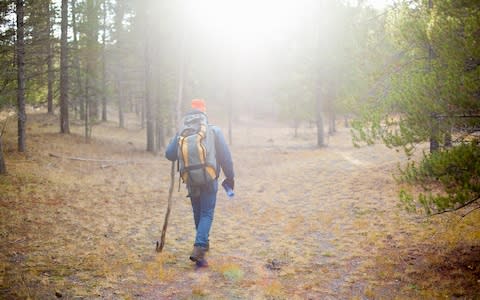
Watch the spectacular geyser Old Faithful blow its top. Track moose, elk and bighorn sheep. Keep your eyes peeled for trumpeter swans, and – fingers crossed – for the most cherished sighting of all – the grey wolves of the Lamar and Hayden Valleys.
Wildlife Worldwide (01962 302086; wildlifeworldwide.com) offers a 17-day holiday led by Nick Garbutt costing from £6,695 per person including flights.
3. Rare sights of the snow leopard, Ladakh
Of all the big cats, the snow leopard presents the greatest challenge – and hence the greatest reward. Solitary, elusive, preferring the half-light of dawn and dusk. It’s a rare creature, too, with fewer than 7,000 spread across 770,000 square miles (almost two million square km) of Central Asia’s rugged mountains.
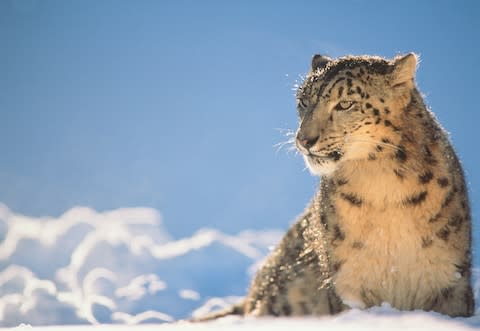
But there are one or two hotspots where your chances increase. Foremost among them is the high-altitude Hemis National Park in Ladakh, where three valleys converge around Husing Camp in an area famously known as “the world capital of the snow leopard”. Even then, with experts on hand to assist in your quest, sightings are not guaranteed. But don’t be put off. This stunning location is home to lots of other Himalayan wildlife including bearded vultures, golden eagles and the snow leopard’s prey: ibex, argali and blue sheep.
Natural World Safaris (01273 691642; naturalworldsafaris.com) has a 14-day trip departing on Feb 17 with prices from £3,875 per person, excluding international flights.
4. Hunting with eagles, Mongolia
This is surely the ultimate winter wildlife challenge: to join the Kazakh nomads in the saddle as they ride out on sure-footed ponies to hunt with eagles in the land where falconry was born 6,000 years ago. To participate, you must travel into one of the most remote corners of the world, to the snow-covered steppes and soaring peaks of the Altai Mountains. It’s a setting as spectacular as the fur-clad horsemen themselves, each with a golden eagle on his fist. Foxes and marmots are their prime targets, but an eagle weighing 15lb (7kg) is also quite capable of taking out a wolf.
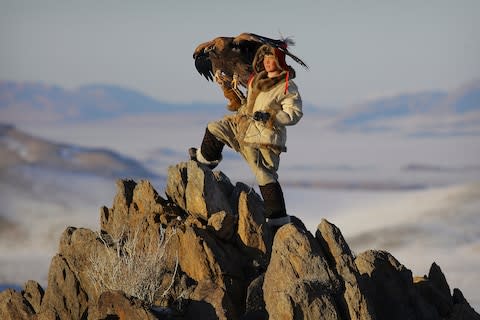
Steppes Travel (01285 601758; steppestravel.com) can put together a tailor-made eight-day trip, allowing three full days with the eagle hunters, from £5,000 per person including flights. The ponies move mostly at walking pace and are the easiest way to travel to and from the hunting grounds, so you don’t have to be an advanced rider. Accommodation is with a local Kazakh family. Flights to Ulaanbaatar are with Aeroflot via Moscow or with Turkish Airlines via Istanbul, followed by a three-hour flight to Olgii, the capital of Mongolia’s far west.
5. Dancing with cranes, Japan
Revered as symbols of love and longevity, Japan’s red-crowned cranes have become a major tourist attraction on the island of Hokkaido. Known in Japan as tancho, these elegant birds gather every winter in the Kushiro Marshes to dance in the snow as their courtship rituals peak in February.
Inside Japan (0117 370 9751; info@insidejapantours.com) can show you the dancing cranes on a 14-night tour that also includes an icebreaker cruise on the Sea of Okhotsk to look for Steller’s sea eagles, and the chance to watch Japan’s famous “snow monkeys” bathing in the Yudanaka hot springs on Honshu island. Prices from £4,150 per person excluding flights.

6. Tracking wolves, Sweden
In the boreal forests of central Sweden, less than three hours by road from the bright lights of Stockholm, live the grey wolves of Kloten. Listen to them as they howl at the moon. Then, when morning comes, put on your snowshoes and join outdoorsman Mikael Nillson in following their tracks, finding their kills and, with luck, catching sight of them across the frozen lakes.

Nordic Discovery (0046 73035007; nordicdiscovery.se) offers this two-night adventure for £289.50 per person. The price includes accommodation at Kloten’s Wilderness Lodge, picnic lunches and candlelit suppers. Flights and transfers not included.
7. Gyrfalcons and Northern Lights, Iceland
No wonder the gyrfalcon is Iceland’s national bird. With a 4ft wingspan it’s the world’s largest falcon, capable of out-flying even a peregrine. True spirits of the Arctic coasts and tundra, gyrs prey mostly on ptarmigan but also hunt ducks and seabirds and will kill animals as big as hares. The best chance to see them is around the snowbound shores of Lake Myvatn. Less than 70 miles (112km) from the Arctic Circle, it’s also an ideal spot from which to enjoy the Aurora Borealis light show.
Five days with Naturetrek (01962 733051; naturetrek.co.uk) costs £1,995 per person including flights. Departures on Feb 8 and Feb 13.

8. Wild wings over the Hebrides, Scotland
When it comes to great winter birding experiences, Britain is right up there with the best of them – and there is nothing more uplifting than the sight and sounds of wild geese flying in to roost in the cold Hebridean twilight. Every year Islay welcomes up to 40,000 barnacle geese and 10,000 Greenland white-fronts, together with smaller numbers of whooper swans and rarities such as the snow goose. Combine Islay with a visit to Mull and see white-tailed eagles, golden eagles and peregrines.
Heatherlea (01479 821248; heatherlea.co.uk) has a five-day trip to Mull and Islay departing March 3 and costing £1,395 per person (single supplement £95).
9. Europe's biggest beast, Poland
Deep in the snow-clad forests of north-east Poland, a fearsome horned apparition appears. It’s a bison, also known as a wisent, the largest land mammal in Europe. Saved from extinction by a captive breeding programme in the Fifties, these magnificent animals now roam at large in the fathomless forests of Bialowieza. And they are not alone. Here, and in the primeval marshlands of the Biebrza National Park, other creatures cling on like a legend: elk, wolf, lynx and beaver. Plus birds to delight the most jaded twitcher: waxwings, black woodpeckers and white-tailed eagles.
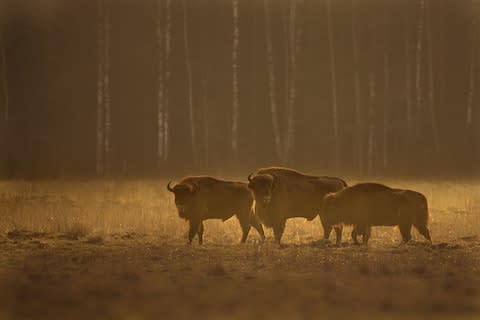
The Travelling Naturalist (01305 267994; naturalist.co.uk) offer a seven-day guided tour to Bialowieza and the Biebrza marshes, departing Feb 28 and March 1 and costing from £1,345 per person including Warsaw return flights.
10. Realm of the ice bear, Svalbard, Norway
Who could forget their first sight of a polar bear? Standing 10ft tall on its hind legs, it is one of the scariest animals on Earth – and Norway’s barren Svalbard archipelago, 620 miles (998km) from the Arctic Circle, is where to find them as they venture out on to the pack ice to hunt seals in the round-the-clock daylight of the brief Arctic summer. Here, the Ice Age has never gone away but in summer the sea ice breaks up sufficiently for custom-built polar cruise ships to plough their way through the floes, sometimes coming within a few yards of bears and their cubs. Out in the tideways, humpback whales surface, only a Zodiac’s length away as you head for the snowbound shores to see walruses, reindeer, Arctic foxes and skies alive with wheeling seabirds.

Exodus Travels (020 3811 5278; exodus.co.uk) offer regular Svalbard voyages from June to August with expert guides on board comfortable Polar adventure ships. This year’s best buy is an exclusive 12-day charter voyage on the Akademik Sergey Vavilov, departing June 8 and led by Paul Goldstein, the award-winning wildlife photographer, and Mark Cawardine, a zoologist. Prices from £5,499 per person (excluding flights to Longyearbyen via Oslo).

